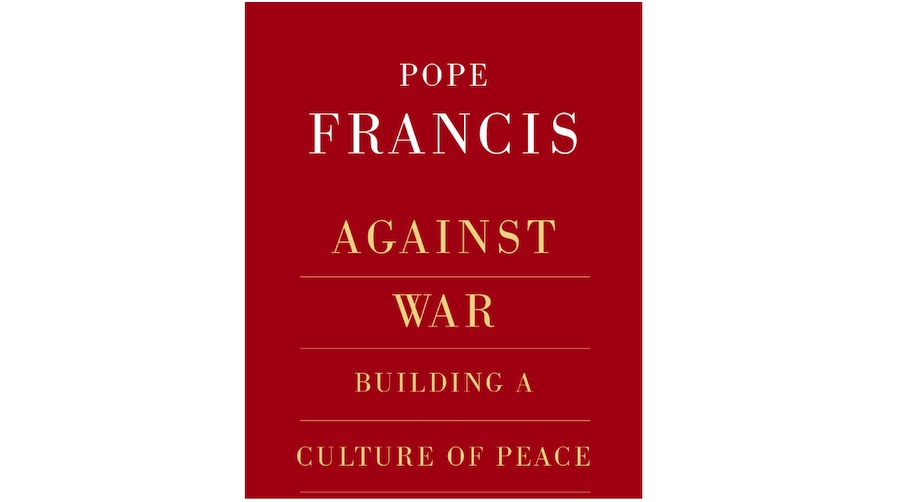EDUCATION FOR PEACE .
Excerpts from an article by William J. Collinge in The Journal of Social Encounters
Against War: Building a Culture of Peace. Pope Francis. Maryknoll, NY: Orbis Books, 2022, paper, viii + 132 pp., ISBN 978-1-62698-499-8.
Against War is a collection of excerpts from the writings of Pope Francis on war and peace. The occasion for the book is the war begun by the Russian invasion of Ukraine on February 24, 2022.

The book begins with an introduction by Pope Francis, dated March 29, 2022. Eight sections of selections follow. The first section, “With War, No One Wins,” consists almost entirely of texts after the outbreak of the Ukraine War. The second section, “A Culture of Death,” gathers texts on the harmfulness of war and the foundations of peace. The third section is titled “The Criminal Folly of Nuclear Weapons,” and it is followed by a section comprising excerpts from Francis’s trip to Japan in 2019, chiefly the speeches he made at Hiroshima and Nagasaki. The next section, “Peace and Fraternity,” contains texts from the Pope’s journey to Iraq in 2021. A major theme is collaboration across religious lines to rebuild Iraq’s war-torn society. The next two sections, “A Better World,” and “An Artisanal Path,” discuss peace and the way to build it. The last section consists of prayers. The book concludes with “Afterword: A Century-Long Magisterium of Peace,” by Andrea Tornielli, the Editorial Director of Vatican News, setting Francis’s teaching in the context of that of his predecessors.
I will summarize what the book says about war and peace in general before turning specifically to what Francis says about the Ukraine War in this book and in subsequent statements.
It is clear that for Francis the enemy is not Russia or any other combatant. It is war. Francis’s emphasis is always on the effects of war, not the state of mind or character of those who declare wars or fight in them. The second line of text speaks of “the disaster caused by war” (p. 1). Francis goes on to speak of the death and wounding of innocent people, especially children, the destruction of homes and displacement of people, the state of fear in which people live, and the transfer of resources from human needs to weaponry. All of this is consistent with recent popes’ increased opposition to modern warfare due to its destructive capacity.
(Continued in right column)
What are the most important books about the culture of peace?
(Continued from left column)
Two themes that are characteristically, though not uniquely, Francis’s are his consistent “option for the poor” and his attention to the environmental costs of war. He urges us to “give first place to those who suffer” (p. 83), to look through the eyes of victims “and listen with an open heart to the stories they tell” (p. 31). He reminds us, “War always does grave harm to the environment” (p. 28), and he calls on us to develop a peaceful relationship to our common home and all who dwell in it (pp. 106–107).
Nuclear weapons, if used, greatly amplify the death and destruction caused by war. The sheer building and possession of them is a huge waste of resources and increases the danger of their deliberate or accidental detonation. “The use of atomic energy for purposes of war is immoral, just as the possessing of nuclear weapons is immoral” (p. 51). Nuclear weapons should be made illegal as well (p. 43). Nuclear deterrence generates a climate of fear and a false sense of security. “Peace and international stability are incompatible with attempts to build upon the fear of mutual destruction or the threat of total annihilation” (pp. 45–46).
What is the alternative to war? Francis would reject that way of formulating the question. For him, there is today “no real alternative to peacemaking” (p. 85). Peacemaking calls for dialogue and encounter, two words that recur frequently in these texts. It calls for “immersing ourselves in situations” (p. 83). In the “culture of fraternal encounter” we must set aside fear and allow ourselves to be vulnerable (p. 98). “Fraternity” is another word that appears very often in this book. It is an awkward term in English, with its etymological gender-exclusiveness (though in American English “fraternity and sorority” would be worse). The Pope’s intention in speaking of fraternity, however, is inclusive, to emphasize that we are all brothers and sisters “as children of the one heavenly Father” (p. 98). He links fraternity to Jesus’s call to love one another, which includes those we might otherwise regard as enemies (pp. 113, 90). Love of enemies implies the rejection of violence in resolving differences: “To be true followers of Jesus today also includes embracing his teaching about nonviolence” (p. 91).
Peace is not a “possession” one can hold on to; rather, it “puts you in motion” (pp. 86–87). It is an “artisanal path” (p. 95), one which everyone can “build … day by day through small gestures and acts” (p. 93). It requires “craftmanship” to build “processes of encounter” (pp. 99–100). Francis concludes, “May the Lord help us to journey together on the path of fraternity and thus to become credible witnesses of the living God” (p. 115).
On the second page of the book, Francis turns to the Ukraine War. He deplores the death and destruction the war has caused (pp. 2, 7) and also the increased arms race it has sparked (p. 9). He worries that it might escalate to nuclear war (p. 4). He calls for “the good sense to negotiate” (p. 17).
Click here to continue reading remarks on the Ukraine War and to read the list of references.